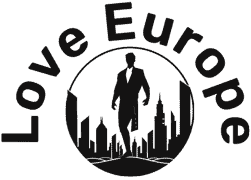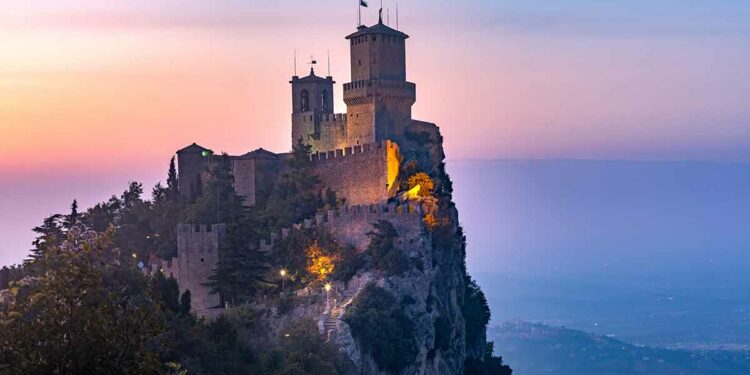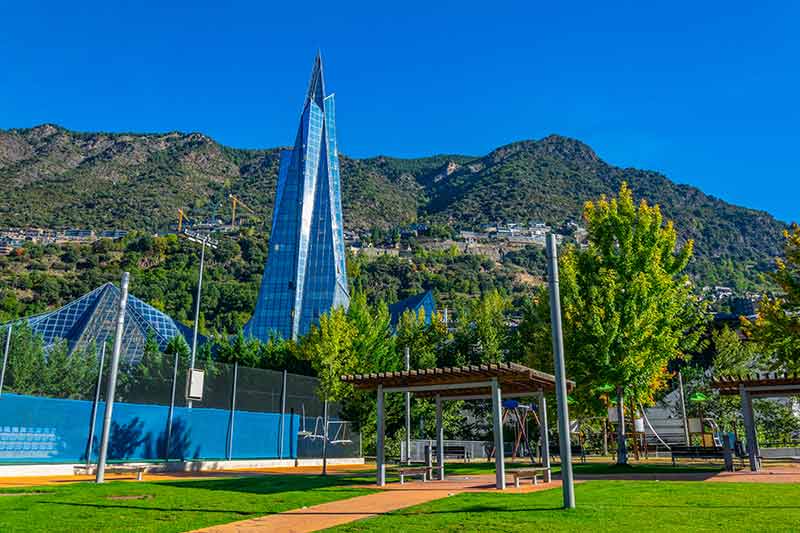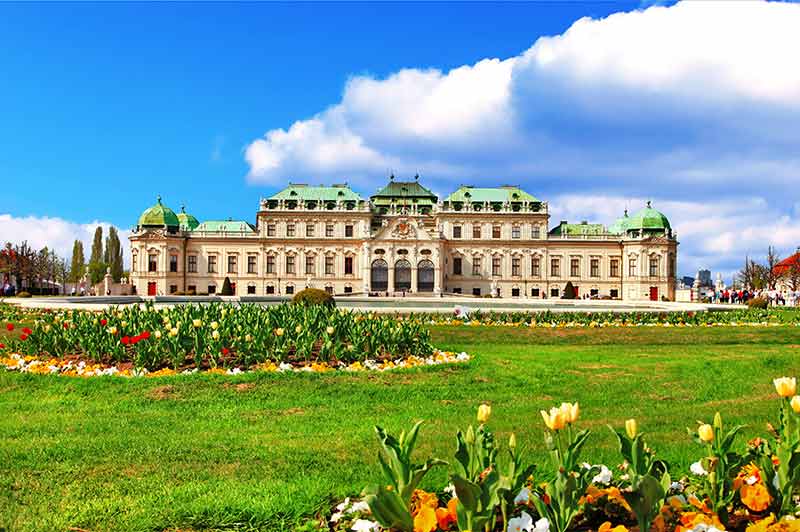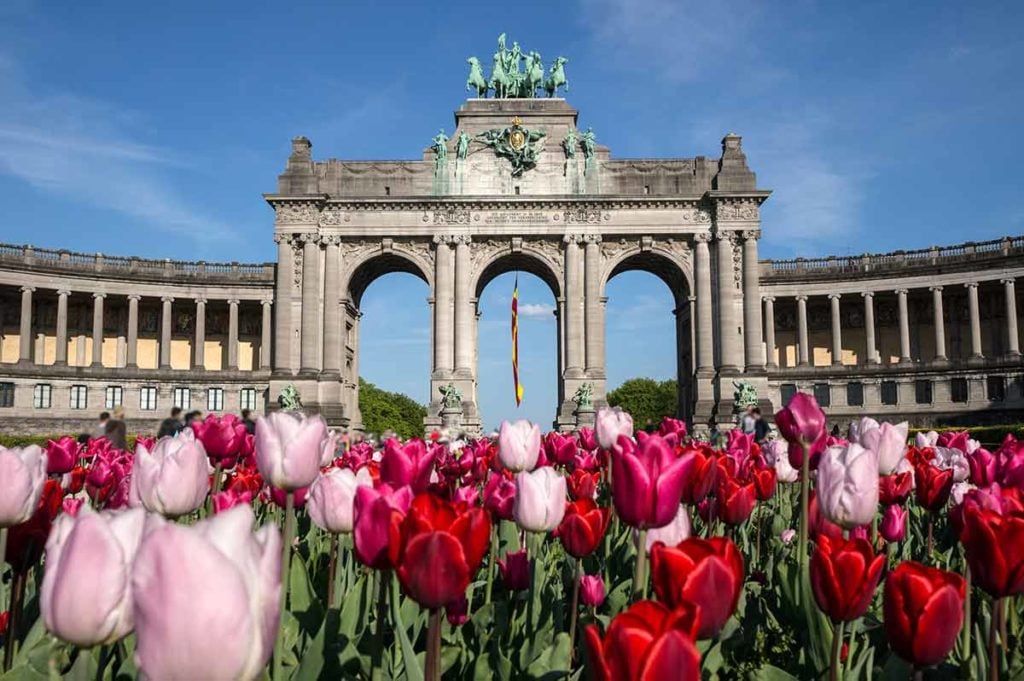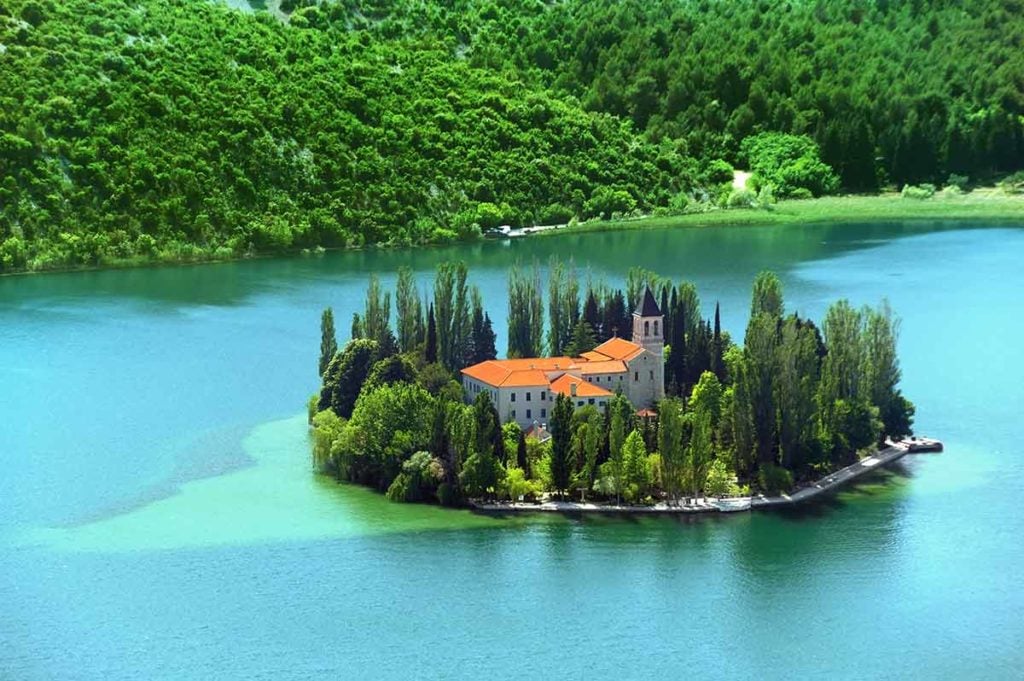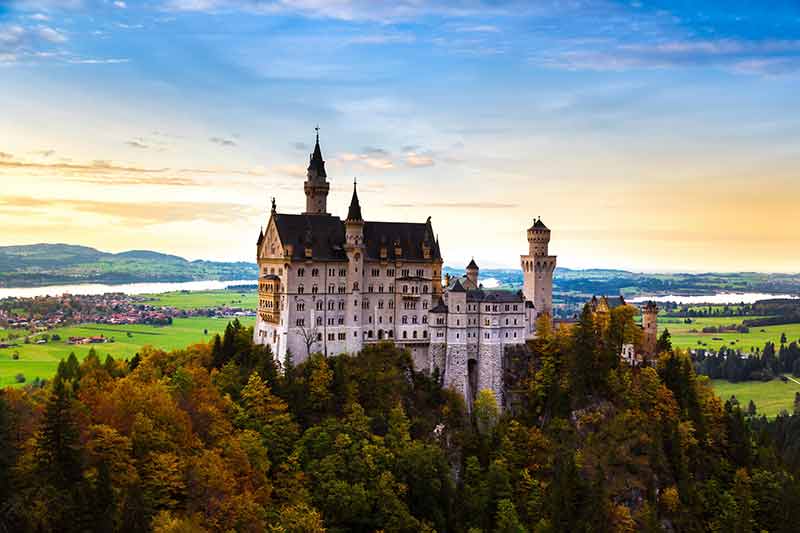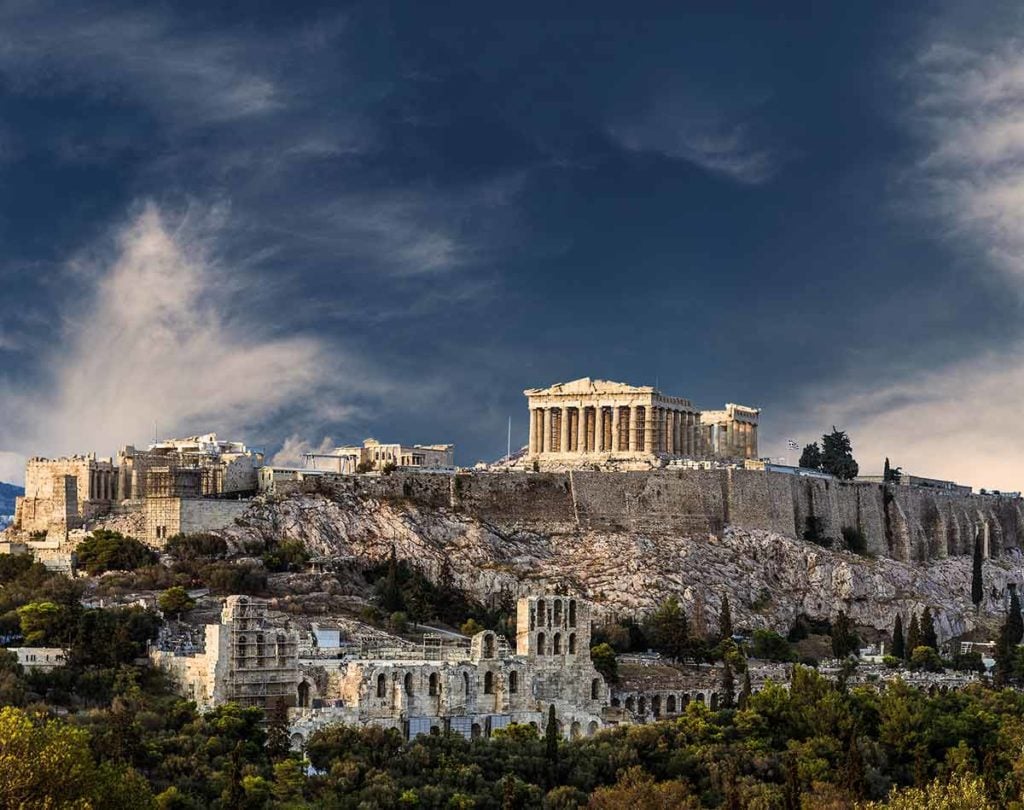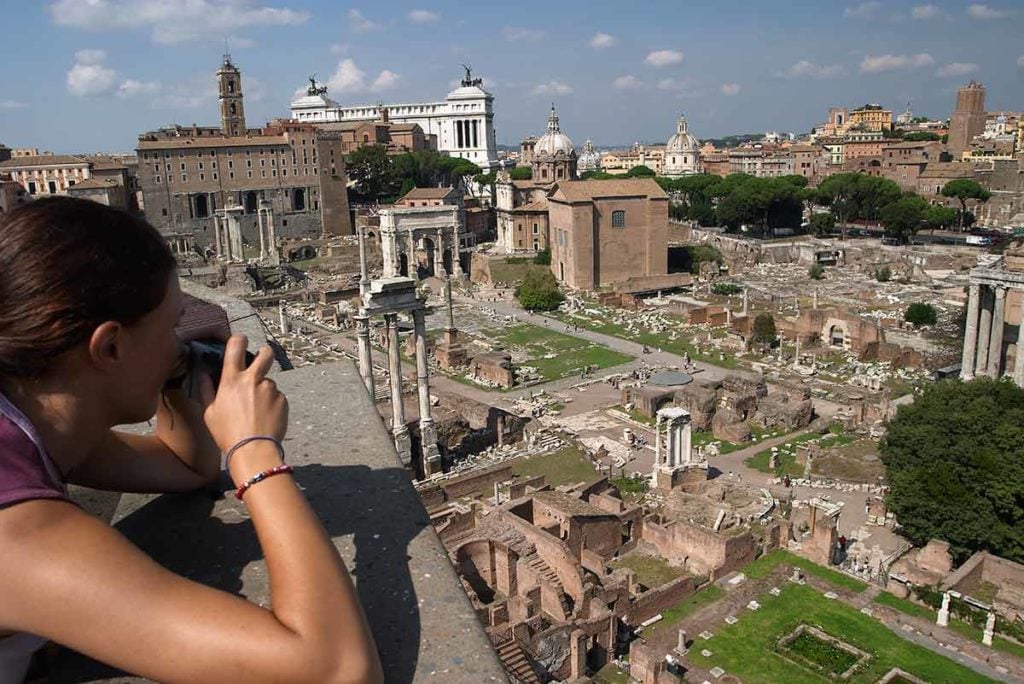Contents
Europe Landmarks For Your Bucket List44 Landmarks in Europe1- Albanian Alps, Albania2- Caldea Spa, Andorra3- Schloss Belvedere, Austria4- Halubaya Krynitsa, Belarus5- Triumphal Arch, Belgium6- Maglić Mountain, Bosnia and Herzegovina7- Belogradchik Rocks, Bulgaria8- Visovac Monastery, Croatia9- Prague Castle, Czech Republic10- Nyhavn, Denmark11- Kaali Meteorite Crater Field, Estonia12- Senate Square, Finland13- Arc de Triomphe, France14- Neuschwanstein Castle, Germany15- Parthenon, Greece16- Apostolic Palace, Holy See17- Lake Héviz, Hungary18- Hvítserkur, Iceland19- Giants Causeway, Ireland20- The Roman Forum, Italy21- Riga Old Town, Latvia22- Vadus Castle, Liechtenstein23- Hill of Crosses, Lithuania24- Casemates du Bock, Luxembourg25- St John’s Co-Cathedral, Malta26- Tipova Monastery, Moldova27- Prince’s Palace, Monaco28- Black Lake, Montenegro29- The Rijksmuseum, Netherlands30- Lake Ohrid, Macedonia31- Trolltunga, Norway32- Slowinski Sand Dunes, Poland33- Belem Tower, Portugal34- Bran Castle, Romania35- Saint Basil’s Cathedral, Russia36- Rocca Guaita, San Marino37- Đerdapska Klisura, Serbia38- Domica Cave and Styx River, Slovakia39- Predjama Castle, Slovenia40- Mezquita, Spain41- Abisko, Sweden42- Jungfraujoch, Switzerland43- Kiev Pechersk Lavra, Ukraine44- Buckingham Palace, United Kingdom
44 Landmarks in Europe
1- Albanian Alps, Albania
The Albanian Alps is a stunning natural European landmark.
Sometimes known as the Accursed Mountains, the Albanian Alps is a mountain range in northern Albania and one of the most stunning landmarks in Europe.
Hiking through the alps offers some of the most staggering natural landscapes in Europe, much of it unspoilt by tourism or development.
The Alps is home to an incredible range of wildlife which includes bears, wolves and wildcats.
The Albanian Alps sit within the National Parks of Thethi, Valbona and the Region of Kelmendi.
In the foothills of these mountains are several small villages giving walkers a glimpse into local culture and delicacies, such as flija, a many-layered pancake cooked on coal fires outdoors and served with local honey.
2- Caldea Spa, Andorra
A landmark in Andorra to visit.
Caldea Spa is the largest thermal spa in southern Europe and a landmark that’s impressive.
The spa began its life in 1987 when the city council decided to harness the powers of the region’s naturally forming hot springs and turn them into a luxurious visitor experience.
The building itself is a work of art. Designed by French architect Jean-Michel Ruols, the building is designed to reference minerals and crystals, as well as the shapes of the mountainous region Andorra is in.
The hot spring water is used throughout the spa in a range of unique and innovative treatments.
The spa is the place to unwind after skiing at Andorra’s impressive resorts.
3- Schloss Belvedere, Austria
Explore this Austrian landmark in Vienna.
Built for Prince Eugene of Savoy between 1700 and 1716, Schloss Belvedere is a baroque palace landmark in Austria with great historical significance.
Reflecting the romantic design of the building and its immaculately landscaped gardens are the artworks housed here.
The palace is two palaces in one, each housing some of Austria’s most famous works of art.
Sala Terrena in Upper Belvedere has a grand statue of Atlas supporting the vaulted ceiling, and in Lower Belvedere visitors can wander the Marble Gallery which is filled with Baroque sculptures.
4- Halubaya Krynitsa, Belarus
The Halubaya Krynitsa, or Blue Spring, is an infrequently visited beauty spot in Belarus.
The spring itself is said to have healing powers, so visitors often brave the year-round freezing temperatures of the water to take a dip.
In ancient times the waters were considered a sacred object, as it was believed a pagan temple was located there.
When Christianity arrived in Belarus, the waters were used to baptise worshippers.
Local legends of this spring tell of two brothers in love with the same woman.
The woman was in love with one brother, and when the wrong one proposed, in anguish at the thought of not being with the man she loved, she hit a stone and became water, turning her into the blue spring.
How romantic and tragic!
5- Triumphal Arch, Belgium
Belgium’s Triumphal Arch is a handsome European monument.
Built to honour Belgium’s 50th birthday, the Triumphal Arch in Brussels marks the entrance to beautiful parklands.
Erected in 1905 to celebrate the independence of Belgium, the Arch was comprised initially of wood and plaster and was officially opened in stone 25 years after the 50th birthday celebrations.
The Arch is the centrepiece of a museum complex and park that comprises of three museums.
Visitors to the Arch can climb to the top to get spectacular panoramic views of the park and the museum buildings.
6- Maglić Mountain, Bosnia and Herzegovina
Maglić mountain is the highest peak in Bosnia and Herzegovina and is within the Sutjeska National Park.
Climbing the mountain is a favourite for mountaineers, as its steep yet beautiful slopes offer a challenging climb to the summit, from which views over the surrounding peaks and national park are seen from 2386m.
It’s an iconic landmark to put on your to-visit list for your next Balkan tour.
7- Belogradchik Rocks, Bulgaria
Check out this impressive landmark in Bulgaria.
An unusually shaped collection of naturally forming rocks, the Belogradchik Rocks in northwest Bulgaria are a must-see European landmark when travelling here.
Each rock making up the Belogradchik Rocks have unusual names such as The Bear, The Camel and The Red Wall, each linked to a legend in local lore.
The rocks stretch over 30km through the countryside and are made of limestone.
The rocks also house caves, in which bones from prehistoric cave bears and hyenas have been discovered.
8- Visovac Monastery, Croatia
Another famous European landmark in Croatia.
Seated on Visovac Island in the middle of Visovac Lake is Visovac Monastery, a Franciscan monastery dating from the mid 16th century.
The buildings are hidden behind a wall of tall cypress trees.
The monastery was initially used as a hermitage before the monks arrived.
During the 16th to 19th centuries, the monks began collecting religious and cultural artworks, and their collection includes a rare illustrated copy of Aesop’s Fables, printed in 1487, which is on display here.
9- Prague Castle, Czech Republic
Prague is home ot many of the most famous landmarks in Europe, such as the Charles Bridge and the clock tower in its old city square.
The Guinness Book of World Records named Prague Castle the largest coherent castle complex in the world, and at 70,000m squared it is easy to see why.
Building works on the castle are believed to have started in 880 by Prince Bořivoj.
Several additions to the castle were made over the centuries that followed, and today the building reflects architectural styles including 10th century Romanesque, and 14th century Gothic.
Its stunning structure and rich history make it one of the most iconic Europe landmarks and visiting the castle one of the top things to do in Prague.
10- Nyhavn, Denmark
Lift your spirits with this colourful landmark in Denmark.
Nyhavn is perhaps Copenhagens most famous location, with its colourfully painted buildings and waterfront views.
Nyhavn was originally a commercial port; however, today, the industrial feel of the port has been transformed with many restaurants populating the buildings.
Hans Christian Anderson, the famous fairytale writer, lived in several houses in Nyhavn and wrote The Princess and the Pea in number 20.
The port area gets bustling during the summer months, so visit during winter, when the warm glow of fairy lights and welcoming local delicacies will make you want to come back.
Call into Havfruen, a seafood bistro for Danish fish and chips, or one of their delicate seafood smørrebrød, the Danish open sandwich.
11- Kaali Meteorite Crater Field, Estonia
Approximately 7500 years ago, a meteorite broke apart and crashed into the earth, causing numerous craters in Kaali on the island of Saaremaa.
In total there are nine craters that vary in size; the largest crater is a gently sloping bowl filled with water.
It is believed that this crater, in particular, was a sacred site due to its origins in space.
In the areas surrounding the craters, archeologists have found evidence of walls and buildings from the Bronze Age, further strengthening the theories that ancient people used these craters.
12- Senate Square, Finland
A striking example of Neoclassical architecture, the Senate Square in Helsinki is made up of four buildings: Helsinki Cathedral, The National Library of Finland, the main building of the University of Helsinki and the Government Palace.
An unusual draw to the square is its sound installation named the Sound of the Senate Square.
This installation is a European glockenspiel that sounds from one building in the square to the next as it travels around.
13- Arc de Triomphe, France
The Arc de Triomphe in Paris is easily one of the most famous landmarks in Europe.
Paris is the jewel of European culture with so many buildings that have incredible architectural beauty. With so many iconic Parisian landmarks, you could spend days seeing them all. How do you choose between the Eiffel Tower, Notre Dame Cathedral and the Louvre, home to incredible art and the French crown jewels?
One not to miss is the Arc de Triomphe, at the top of the Champs-Élysées, built in the early 1800s to honour the troops of Napoleon I’s Grand Armée.
The Arc de Triomphe was inspired by the grand arches seen in ancient Rome and Greece.
The monument itself is a memorial to the soldiers and generals from the French Revolution and the First Empire, with their names carved into the stone.
A further memorial act comes from the flame lit each evening on the tomb of the Unknown Soldier from the Great War.
Visitors can climb the Arc de Triomphe for spectacular views down the Champs-Élysées, which is one of the world’s most famous avenues.
14- Neuschwanstein Castle, Germany
Who doesn’t love a fairytale? That’s why this castle is one of the most visited landmarks in Europe.
Many of the famous landmarks in Europe are in Germany, with incredible landmarks ranging from World War II (like the Berlin Wall) to Anne Frank House, Brandenburg Gate and other monuments with striking architecture.
Surrounded by thick forests with towers stretching up against the mountainous backdrop is Neuschwanstein Castle, which is one of the most iconic European landmarks.
The castle was built on a hillside in 1868 by King Ludwig II of Bavaria shortly after the conquering of Austria and Bavaria by Prussia in the Austro-Prussian War.
This Bavarian castle is the most visited in Germany, and its reputation for being a fairytale castle stretches further than King Ludwig II’s desires for it to hark back to the castles of old German Knights.
It is rumoured that this castle was the inspiration for the castle in Disney’s Cinderella, as well as Sleeping Beauty’s castle in Disneyland.
15- Parthenon, Greece
Another European landmark to tick off your bucket list is the Parthenon in Greece.
Some of the most iconic landmarks in the continent can be found in Greece.
Originally built in the mid-5th century BCE for the goddess Athena Parthenos atop the hill of the Acropolis is the famous Parthenon.
The temple was made from white marble, however much of it has been damaged over the centuries, leaving only a basic structure with fluted columns and roof remaining.
Many reliefs are carved throughout Parthenon representing battles between gods and giants, the birth of Athena and her contest with sea god Poseidon.
During the 19th century, a section was removed and placed in the British Museum in London, which are now referred to as the Elgin Marbles.
If you’re a fan of ancient Greece, the nearby Acropolis Museum is not to be missed either.
16- Apostolic Palace, Holy See
In what is often called Vatican City, the Apostolic Palace in the Holy See is the official residence of the Pope.
Construction on the palace began in the late 1500s and was completed over the course of four papacies.
The palace is formed of many important buildings in the Holy See including the Vatican Library, the Vatican Museums and the Papal Apartments.
The palace also houses the Sistine Chapel and Raphael’s Rooms.
Within the grounds of the palace are beautifully kept gardens and ponds, conservatories, an observatory and even a cattle premises where cows are bred to provide milk for the whole palace.
17- Lake Héviz, Hungary
Although Budapest has some of the most famous landmarks in Europe, the largest natural medicinal body of water in the world deserves a mention.
Budapest may be home to excellent public baths but you can enjoy the benefit of Hungary’s healing waters and the lake’s timeless beauty at the same time.
With its waters flowing from a spring cave on the surface, the lake has a temperature of 40°C which is dictated by both hot and cold springs mixing together.
Locals have used the lake for over 2000 years for its thermal properties.
In the 18th century, the lake was turned into a spa village.
The waters of the spa offer visitors a range of proven healing properties, including the prevention and treatment of joint diseases, and is often used by locals as a recovery treatment following injuries.
18- Hvítserkur, Iceland
Known as the Troll of Northwest Iceland, Hvítserkur is a basalt rock formation in Húnaflói Bay.
Due to its watery location, Hvítserkur is popular with photographers as the aurora borealis reflects off the surface of the water.
The nickname Troll reflects the importance of trolls in local folklore.
It is said that Hvítserkur was a troll who was determined to remove the bells from a nearby convent, as Iceland was being forced to turn to Christianity and away from the Old Norse Gods.
Hvítserkur was so enraged by this act that as he was trying to reach the convent, he did not notice the rising sun, and was turned to stone in the middle of the bay.
19- Giants Causeway, Ireland
On the coast of the North Atlantic Ocean and surrounded by imposing cliff faces is Giants Causeway, one of the most famous landmarks in Europe.
Giants Causeway is in Co. Antrim in Northern Ireland and forms part of the Causeway Coast.
The Giants Causeway is a UNESCO World Heritage Site and is shrouded in myth and legend.
The stones of the causeway rise and fall out of the sea in unique patterns giving the landscape an unusual texture.
Each of the basalt stone columns was formed during a volcanic eruption 60 million years ago.
20- The Roman Forum, Italy
The Roman Forum is an impressive landmark in Europe for history lovers to explore.
Italy is another country with so many Europe landmarks of historical significance, from ancient ruins to the famous leaning tower Pisa to the gems of the Vatican City.
A short walk from the Colosseum, which is one of the most iconic landmarks, is the Roman Forum, an important centre of Ancient Rome.
The forum is a rectangular piece of land between Palatine Hill and Capitoline Hill and was filled with temples and monuments to Roman gods.
According to ancient legend, following the creation of Rome by brothers Romulus and Remus in 753BC, Romulus created the forum as a neutral meeting place for his rival Titus Tatius.
Over time the forum became a place for public meetings, elections, religious ceremonies and even had gladiators fighting there before the Colosseum was built.
Visiting the Roman Forum is one of the fantastic things to do in Rome at night.
21- Riga Old Town, Latvia
Narrow cobbled streets and medieval architecture make Riga’s Old Town a must-see on anyone’s travel list. Its iconic landmarks make it even more enticing to visit.
When visiting head to Maza Pils Street where The Three Brothers, the three oldest dwellings in Riga, can be found.
The three buildings are all from different architectural periods in time; the 15th century Gothic, the Dutch Mannerist influence, and the 17th century Baroque.
Today the Three Brothers house the Latvian Museum of Architecture.
Pause in one of the cafes and sample a Riga Black Balsam, Latvia’s national drink, while admiring the impressive architecture of the 13th-century town hall.
22- Vadus Castle, Liechtenstein
It may to be one of the more famous landmarks in Europe but Vadus Castle is certainly one of the most fascinating.
The Prince of Liechtenstein’s official residence, Vadus Castle is an imposing hilltop castle with views over the capital city of Vadus, which is named after the castle.
The castle was constructed during the 12th century and further additions were made during the 1600s.
As the castle is still the official residence of the Prince of Liechtenstein, it is not open to the public, however, views of this spectacular castle can be seen following hikes in the surrounding woodlands.
23- Hill of Crosses, Lithuania
With its origins, a mystery, the Hill of Crosses in Lithuania is a small hill with over 1000 crosses of different designs and sizes adorning every possible surface.
The crosses have been placed on the hill for over 200 years and are made from metal or wood.
Mixed amongst the crosses are rosaries and photographs of saints and local patriots.
The Hill of Crosses has been destroyed four times in its history, most recently in 1961 when it was bulldozed and burnt by local authorities.
Locals hope that visitors to the hill will become educated into the communities turbulent and painful past while leaving with a feeling of hope. It’s certainly one of the more unusual Europe landmarks for your to-see list.
24- Casemates du Bock, Luxembourg
Built in 963 by Count Siegfried, Casemates du Bock is an important part of the history of Luxembourg.
There have numerous attempts throughout history to conquer the city and bring down the castle, however, due to its construction of three fortified rings, 24 courts and underground networks, the castle proved untouchable without destroying the city itself.
The fortress was eventually dismantled in the 1800s however 17km of the Casemates were spared and are now open to the public to explore.
For more amazing European Landmarks read:
25- St John’s Co-Cathedral, Malta
One of the things to do in Malta is to explore St John’s Co-Cathedral. Built by the Knights of Malta between 1572 and 1577, St Johns Co-Cathedral is a beautiful Baroque Roman Catholic cathedral.
One of the artistic treasures of Malta, inside the cathedral are paintings from Caravaggio which were donated by Knights of the Order of St. John.
The interior of the cathedral is a visual masterpiece of intricate artwork adorning the ceilings, stained glass windows and gilded carvings and arches leading worshippers and visitors into smaller side chapels.
26- Tipova Monastery, Moldova
Tippova Monastery is a cave monastery built into the cliffs close to the village of Tipova. The layout of the monastery is simple in comparison to other larger monasteries in Europe.
Comprising of three religious chambers and monastic cells, the monastery is precariously built into the rock face.
The oldest part of the monastery is one of the religious chambers which is believed to date from the 11th century.
Sadly, the monastery was destroyed during the Soviet period, however, the ruins became protected during the 1970s and have since opened for religious use.
27- Prince’s Palace, Monaco
The Prince’s Palace of Monaco is home to the royal family of Monaco.
The palace was constructed at the beginning of the 13th century and was captured by Francesco Grimaldi in 1297.
Located on Monaco Rock next to the Old Town, the palace has been home to the Grimaldi family for more than 700 years.
During her marriage to Prince Rainier III, Hollywood actress Grace Kelly lived there and raised her family.
Certain areas of the palace are open to the public to visit, but this is limited to only a few months a year.
28- Black Lake, Montenegro
Black Lake in Montenegro is a glacial lake in the Durmitor mountain range and one of the most incredible sights in the country.
Black Lake is one of 18 lakes in the range known collectively as gorske oči, or mountain eyes.
A thick pine forest surrounds the lake and Međed, the bear, a mountain in the range rises from its banks.
Black Lake is a welcome stopping point for hikers through the Durmitor range, and its blue waters are popular for wild swimming.
29- The Rijksmuseum, Netherlands
The Rijksmuseum is a museum in Amsterdam dedicated to Dutch art and history.
The paintings displayed here include The Milkmaid by Vermeer and The Night Watch by Rembrandt, alongside other masterpieces from the Dutch Golden Age of Art.
The museum is comprised of 80 galleries of more than 8000 objects and paintings, all of which tell stories of the Netherlands and its history.
30- Lake Ohrid, Macedonia
Lake Ohrid is over 3 million years old and is one of the oldest and deepest lakes in Europe. That makes it one of the Europe landmarks worth a mention.
The lake is a UNESCO World Heritage site and shares the title with Ohrid, the town that sits on its banks.
Some scientists believe that this lake is the most biodiverse body of water of its size as it’s home to over 200 species.
Ohrid, an old town that descends a steep hillside to the waters below, is sometimes nicknamed ‘Jerusalem of the Balkans’ as it is one of the oldest settlements in Europe and a religious centre for the surrounding areas.
31- Trolltunga, Norway
Following a long and at times demanding hike, walkers in the Hardangervidda plateau are rewarded with Trolltunga, a rock formation that stretches out from the range 700m above the lake below.
The name Trolltunga translates to Troll Tongue, given its unusual shape and protrusion from the rocks around it.
The cliff hovers above Ringedalsvatent lake giving incredible panoramic views over the lake and the surrounding mountain range.
It is recommended to always hike with an experienced guide or join a guided tour as the weather changes quickly.
32- Slowinski Sand Dunes, Poland
One of the lesser-known Europe landmarks on this list is the Slowinski Sand Dunes in Poland.
The dunes are part of the Slowinski National Park which also comprises of inland lakes and forests, and are a part of the UNESCO list of World Biosphere Reserves.
The dunes move in the wind, approximately 10m per year, and as such their height varies, with the highest dune often reaching 32m on average.
33- Belem Tower, Portugal
Belem Tower became a UNESCO World Heritage site in the 1980s and is one of the most popular spots in Portugal.
Built in the early 1500s on the banks of the Tagus River, the tower was designed to defend Lisbon from attacks making it an important icon in European history.
Following its demilitarisation, the tower began life as a lighthouse, with the top window reflecting light over the waters below.
The tower has five floors, with spiral staircases connecting them, leading visitors to the roof terrace.
34- Bran Castle, Romania
A world away from Romania’s busy capital of Bucharest, Bran Castle is a fortress in the Carpathian Mountains of Romania.
The fortress was an architectural wonder initially built in the 13th century by Teutonic Knights.
They saw the benefits to such a strategic location within the mountain range, as the castle is built at a crossroads to essential trade routes.
It is believed that the castle was the inspiration for Bram Stoker as he wrote Dracula, due to its imposing location and legend that Vlad the Impaler (who was also known as Vlad Dracul) was imprisoned here.
35- Saint Basil’s Cathedral, Russia
St Basil’s Cathedral in Moscow was originally built in 1555 at the request of Ivan the Terrible, Russia’s Tsar.
The famous landmark was designed to symbolise the Heavenly City, and references to this can be found in the intricate carvings adorning the cathedral walls and towers.
The cathedral uses bold colours and gemstones, making it, unlike many other European cathedrals who tend to have simply carved sandstone walls and richly decorated interiors.
The cathedral is nine churches in one, and each section is connected internally by galleries and passages.
36- Rocca Guaita, San Marino
Encircled by Italy, San Marino has a history filled with a need to protect itself from attack or invasion.
Rocca Guaita is one of three castle towers in San Marino designed for such a purpose.
The castle itself dates from the 10th century, however, the prison quarters were built much later.
Rocca Guaita offers visitors an insight into what life was like at this small military stronghold, as well as inviting them to view some unusual prisoner art.
Hidden beneath over 200 years of whitewash are examples of prison graffiti that ranges from simple scrawls of names to more intricate portraits of soldiers and depictions of their sometimes troubling daily lives.
37- Đerdapska Klisura, Serbia
Đerdap National Park is Serbia’s largest national park and is filled with amazing landmarks and archaeological sites of historical significance.
Đerdap Klisura, or Đerdap Gorge, is the most significant drawcard to the park.
The gorge was formed when the River Danube changed in width from several kilometres to just a couple of hundred meters.
The views over the gorge from the surrounding cliffs are spectacular.
38- Domica Cave and Styx River, Slovakia
First discovered in 1926, the Domica Cave is an unusual network of caves and underground rivers.
The caves feature spacious domes, stalactites and stalagmites, and is home to 16 different species of bats.
When touring the cave, visitors can explore via a boat trip on the underground Styx River.
39- Predjama Castle, Slovenia
Perched on a 123-meter high cliff stands Predjama Castle, an 800-year-old castle with a network of hidden tunnels and caves behind its walls.
The castle has been named as the worlds largest cave castle by the Guinness Book of World Records.
The castle is one of Europe’s most beautiful, thanks to its unusual location and Gothic architecture.
40- Mezquita, Spain
Mezquita is an incredible example of Islamic architecture in Spain, it’s a mosque in Córdoba that dates back to the 10th century.
At the time of construction, Córdoba was the largest and most prosperous city in Europe for science, culture and the arts, and as such made the perfect location for the building of Mezquita.
The mosque is accessible through orange groves and grand fountains.
Inside, space is separated by columns supporting the vaulted ceilings, with colourful light filtering through.
41- Abisko, Sweden
Abisko, a 75 square kilometre national park in Sweden, reaches into the countryside from the shores of Lake Torneträsk.
Many visitors here come to hike the parklands and to see the midnight sun in summer.
The biggest allure to the park, however, is in winter, when the northern lights are visible.
Tours are frequently run away from the small towns and into the park where light pollution will not detract from the spectacular skies above.
It’s one of the impressive things to do when planning your Sweden itinerary.
42- Jungfraujoch, Switzerland
Described as being ‘on the top of Europe’, Jungfraujoch is a spectacular viewing platform in the heart of the Swiss Alps.
The Jungfrau railway has brought visitors up to this platform, which is Europes highest-altitude railway station, for more than 200 years.
Surrounding the station are spectacular views over the snow-covered alps which are visible from one of three viewing platforms on site.
43- Kiev Pechersk Lavra, Ukraine
Lavra, a golden-domed monastery, is a must-visit landmark when in Ukraine.
The monastery was founded in 1051 by two monks and has remained a significant site for Eastern Orthodox Christianity since, with many pilgrims journeying here.
The monastery sits above a network of underground tunnels filled with mummified monks and religious relics.
This underground shrine is said to have a more significant spiritual effect on those practising their religion in the monastery above due to the artefacts it houses.
44- Buckingham Palace, United Kingdom
London has its fair share of famous landmarks in Europe, such as Tower Bridge that stretches across the River Thames and the Tower of London (home to the crown jewels), but there’s none as famous as Buckingham Palace.
The official London residence of the UK royal family since 1837, Buckingham Palace is a royal palace that is one of the most famous landmarks in London.
The palace consists of 775 rooms, including 19 staterooms that are open to the public. Yes, it’s a popular tourist attraction!
The palace hosts many public events throughout the year, including regular tours of the staterooms, the Queen’s Garden Parties, and State banquets.
The balcony is perhaps the most famous area of the Palace. The first royal appearance here was in 1851 when Queen Victoria marked the opening of the Great Exhibition.
The daily changing of the guard is an attraction at the entrance to the palace, which has long been a draw for tourists far and wide.
Looking for more tours in the world’s most popular places, check out these:
Source link : http://www.bing.com/news/apiclick.aspx?ref=FexRss&aid=&tid=67447297be3046fbae3950f1bc939f8b&url=https%3A%2F%2Ftravel2next.com%2Feurope-landmarks-monuments%2F&c=2824673302636790946&mkt=de-de
Author :
Publish date : 2024-11-25 00:55:00
Copyright for syndicated content belongs to the linked Source.
